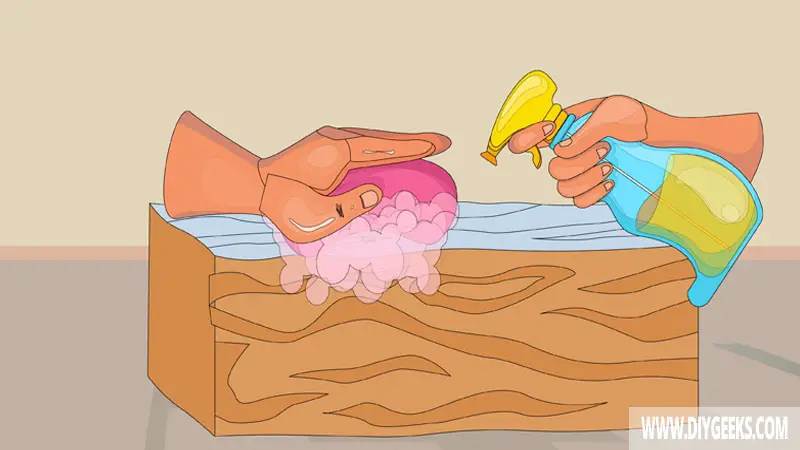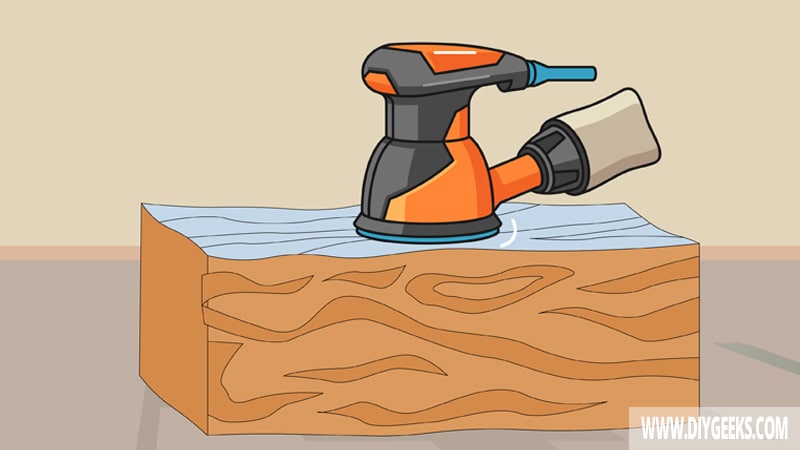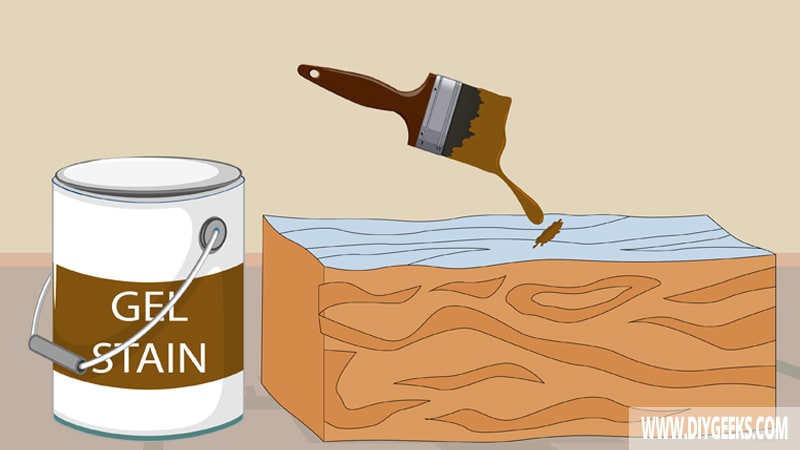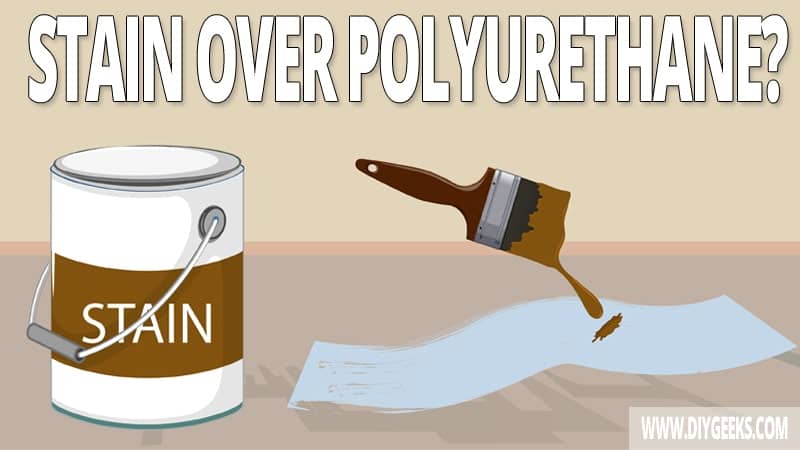You can stain over polyurethane if you sand or remove the polyurethane finish first or use gel stain. If you don’t sand or remove the polyurethane finish first, regular wood stain can’t adhere over it.
To stain polyurethane, clean the finish, sand the polyurethane, and apply the wood stain.
Staining polyurethane is also called wood glazing, which refers to applying gel stain between layers to create an antiqued effect. However, to achieve a wood glazing effect, you must also seal (with a moisture-resistant sealer) the gel stain after applying it.
Does Wood Stain Adhere Over Polyurethane?
Wood stain doesn’t adhere over polyurethane finish as the finish has moisture-resistant layer (barrier) that prevents stain penetration and adhesion. However, topical wood stain (gel stain) can adhere over it since it doesn’t need to penetrate its finish.
Regular wood stain is a penetrating finish, it needs to penetrate the surface pores to stick. Since polyurethane forms a moisture-resistant barrier (or top coat), wood stain can’t penetrate its surface (or finish) and won’t stick.
The wood stain will stay over the polyurethane coating for hours and won’t dry or stick if you apply it over polyurethane. So, you must remove the polyurethane coating first, then apply the wood stain.
Gel stain sticks over polyurethane as it isn’t a penetrating finish and doesn’t need to penetrate a surface to stick.
Can You Stain Over Polyurethane Without Sanding?
You can’t stain over polyurethane without sanding as polyurethane forms a protective layer that is moisture-resistant, UV-resistant, scratch-resistant, glossy, and sustainable. This protective layer prevents wood stains from penetrating or sticking.
You must sand off the polyurethane finish to create tiny pores (or holes) so the wood stain can penetrate and adhere.
To sand polyurethane before staining, use fine-grit sandpaper (220 grit) as you only need to scratch its finish a bit, and not remove it.
Don’t use coarse or medium-grit sandpaper (40-100 grit) as they can remove the entire finish and damage the surface (wood) underneath.
How Long Does Polyurethane Need To Dry Before Staining?
Oil-based polyurethane needs to fully dry (cure) for 48-72 hours, while water-based polyurethane must fully dry (cure) for 24 hours before staining over it.
The exact dry and cure time depends on the humidity levels, room temperature, thickness of the coat, surface type, and environmental conditions.
If you stain too soon, the finish will remain wet longer, turn sticky, won’t dry, and won’t be strong enough to handle another coating. A wet coating will still have its solvent (water or oil) on it and this will prevent a new coating from sticking.
You must wait until the solvent (water or oil) fully evaporates from the coating before applying a new coating over it.
Benefits of Staining Polyurethane
The benefits of staining polyurethane are as follows.
- Color Transformation. Applying gel stain over polyurethane will update the color of the finish or surface without having to remove the polyurethane.
- Time and Cost Saving. Staining polyurethane will save you time and money compared to stripping the polyurethane, sanding the surface, and re-applying it from scratch. It eliminates the need of stripping the existing finish and applying more coats of it later.
How To Stain Over Polyurethane?
To stain over polyurethane, do the following things.
- Clean the Finish
- Sand the polyurethane.
- Apply the Gel Stain
Note: You can only use gel stain after polyurethane, if you use other types of stain they won’t stick.
The tools you need for this project are listed below.
- Gel stain
- Foam brush or a regular paintbrush
- Rags
- Fine-grit sandpaper
- Orbital or palm sander (for large surfaces)
- White vinegar or white spirits
- Painter’s tape (optional)
1. Clean the Finish

Clean the polyurethane finish with a damp rag to remove dust, dirt, oils, and grease that can prevent wood stains from adhering to it.
Remove the polyurethane finish completely with mineral spirits or paint-stripping paste, if you want a better stain adhesion.
2. Sand the Polyurethane

Sand the polyurethane finish to remove surface imperfections and bumps, and create tiny holes (pores) over the finish.
To sand polyurethane before staining, use fine-grit sandpaper (220- grit). The fine-grit sandpaper won’t damage or dull the finish, instead, it will only remove the imperfections from the coating. Don’t use medium or coarse-grit sandpaper (40-100 grit) as they can remove the finish or make it blurry.
After sanding, clean the finish will a clean rag and remove any dust or dirt over it. There’s no need to apply primer, wood conditioner, or an undercoat.
3. Apply the Wood Stain

Apply two (2) wood stain coats over the polyurethane using a paintbrush or rag. Wait until one coat dries, wipe the excess, and apply the next coat. If you don’t wipe the wood stain excess, the finish can turn sticky, tacky, take longer to dry, or can peel off.
Re-seal the finish with two (2) polyurethane coats to increase durability and moisture resistance.
Is It Necessary To Apply Stain After Polyurethane?
It’s not necessary to apply stain after polyurethane as polyurethane forms a moisture, scratch, and UV-resistant glossy finish that doesn’t need extra protection.
You can apply two (2) gel stain coats to change (tint) the color shade. However, there are tinted polyurethanes that come with a colorful finish.
What Stain Types Can You Apply Over Polyurethane?
You can only apply Gel stain over polyurethane if you don’t remove the finish. Gel stain is a topical finish that doesn’t need to penetrate a surface to adhere.
Don’t use regular wood stain over polyurethane coating as it won’t adhere unless the remove the sealer finish first. Polyurethane forms a moisture-resistant, UV-resistant, and glossy finish that prevents regular wood stains from penetrating its surface and adhering.
How Long Must Gel Stain Dry Over Polyurethane?
Gel stain must dry fully (cure) for 24 hours over polyurethane before re-staining it and 24 hours before exposing the finish to regular use.
Gel stain has a slower dry time because of its thickness which takes longer to solidify and its solvent (oil) takes longer to evaporate.
Can You Mix Stain With Polyurethane?
Yes, you can mix stain with polyurethane, but only if they have the same solvent. This means you can mix oil-based stain with oil-based polyurethane and water-based stain with water-based polyurethane.
Some manufacturers also sell a stain+poly finish that it’s already mixed and ready to use.


